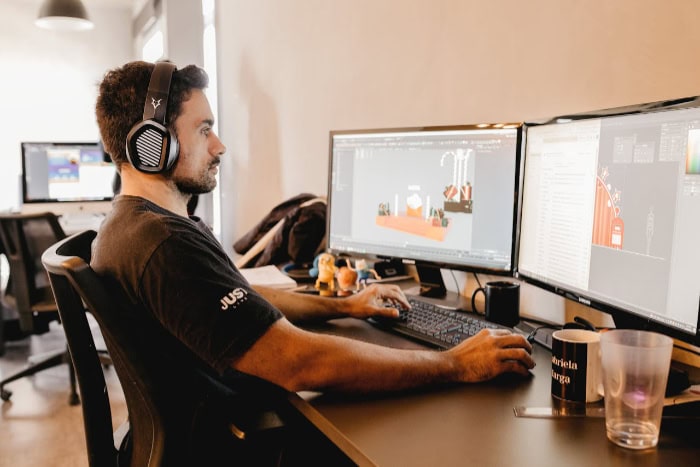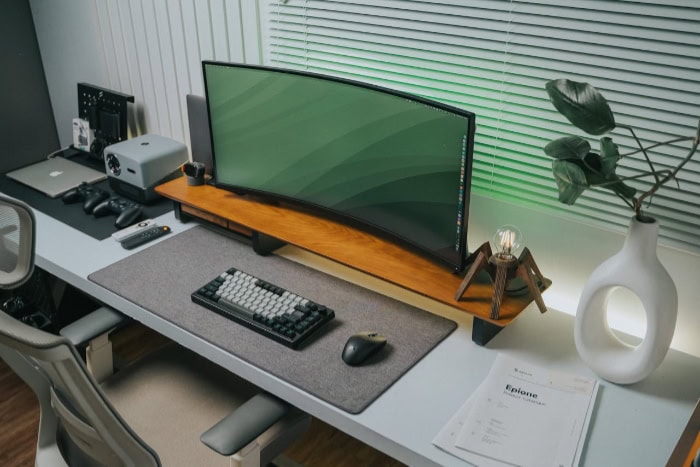60Hz vs. 144Hz vs. 240Hz Monitors: Worth the Upgrade?

Refresh rates have become a hot topic among tech enthusiasts and gamers alike. As monitor technology advances, the numbers keep climbing: 60Hz, 144Hz, 240Hz.
But what do these figures mean for your viewing experience? From smooth motion to reduced eye strain, the impact of refresh rates extends far beyond mere specifications.
Monitor Refresh Rates Explained
Monitor refresh rates play a crucial role in determining the quality and smoothness of your visual experience.
Hz, short for Hertz, measures the number of times a monitor refreshes its image per second. For example, a 60Hz monitor updates its display 60 times every second, while a 144Hz monitor refreshes 144 times per second.
This rapid refreshing creates the illusion of smooth motion on your screen.
Refresh Rates and Image Quality
Higher refresh rates result in smoother and more fluid motion on your screen. As the monitor updates more frequently, it reduces the time between each frame, minimizing visual artifacts like screen tearing and motion blur.
This improvement becomes particularly noticeable in fast-moving content, such as action movies or video games.
A 60Hz monitor, while adequate for many tasks, may display some choppiness during rapid movements. In contrast, 144Hz and 240Hz monitors offer significantly smoother motion, with 240Hz providing the most fluid visual experience currently available to consumers.
Refresh Rates vs. Frame Rates
Refresh rate and frame rate are closely related but distinct concepts. While refresh rate refers to how often a monitor can display new images, frame rate (measured in frames per second or FPS) indicates how many unique images a device, like a computer or gaming console, can generate each second.
For optimal performance, the frame rate should match or exceed the monitor's refresh rate. If a computer generates 144 FPS but the monitor only refreshes at 60Hz, the extra frames are essentially wasted.
Conversely, if a monitor has a 144Hz refresh rate but the computer only produces 60 FPS, the monitor will display some frames multiple times, not fully utilizing its capabilities.
It's important to note that while a high refresh rate monitor can display more frames, it doesn't automatically increase the frame rate of the content. The source device must be capable of producing enough frames to take full advantage of the monitor's refresh rate.
Visual Experience and Display Smoothness

The perceived differences between 60Hz, 144Hz, and 240Hz monitors can be quite striking, especially when viewing fast-moving content or performing rapid mouse movements. A 60Hz monitor, while suitable for many everyday tasks, may exhibit noticeable stuttering or choppiness during quick screen transitions or in fast-paced games.
Stepping up to a 144Hz monitor provides a substantial improvement in smoothness. The increased refresh rate results in more fluid motion, making scrolling, gaming, and video playback appear much more natural and responsive.
The jump from 60Hz to 144Hz is often described as one of the most noticeable upgrades a user can experience.
The difference between 144Hz and 240Hz, while less dramatic, is still perceptible to many users, particularly in competitive gaming scenarios. A 240Hz monitor offers even smoother motion and can provide a slight edge in fast-paced games where split-second reactions matter.
However, the improvement is generally less noticeable in everyday computing tasks compared to the jump from 60Hz to 144Hz.
Enhancing Motion Clarity
Higher refresh rates contribute significantly to improved motion clarity and a reduction in motion blur. Motion blur occurs when our eyes track a moving object on screen, but the display can't keep up with the speed of the movement, resulting in a blurred or smeared appearance.
At 60Hz, fast-moving objects or rapid camera pans can appear blurry or leave noticeable trails. This effect is reduced at 144Hz, with objects retaining more of their sharpness during motion.
At 240Hz, motion clarity is further enhanced, with even less blurring and smoother transitions between frames.
This improvement in motion clarity is particularly beneficial for gaming, sports broadcasts, and action movies. Gamers can track moving targets more easily, while viewers of fast-paced content will experience clearer, more detailed motion.
Gaming Performance and Competitive Edge

Refresh rates play a crucial role in gaming performance, offering potential competitive advantages in various game genres. Higher refresh rates can significantly impact input lag, responsiveness, and overall gameplay experience, particularly in fast-paced and competitive gaming environments.
Input Lag and Responsiveness
Input lag, the delay between a player's action and its reflection on screen, is a critical factor in gaming performance. Higher refresh rates directly contribute to reduced input lag, creating a more responsive gaming experience.
At 60Hz, the delay between frames is approximately 16.67 milliseconds. This jumps to about 6.94ms for 144Hz displays and further reduces to around 4.17ms for 240Hz monitors.
While these differences may seem minuscule, they can have a noticeable impact on gameplay, especially in competitive scenarios.
The reduced delay in higher refresh rate monitors allows for quicker visual feedback of player actions. This improved responsiveness can enhance a player's ability to react to in-game events, potentially providing a competitive edge in scenarios where split-second decisions matter.
Moreover, the smoother motion provided by higher refresh rates can make it easier to track moving objects or targets in games. This improved visual clarity can be particularly beneficial in first-person shooters, racing games, and other fast-paced genres where precise tracking is essential.
Advantages in Fast-Paced and Competitive Games
The benefits of higher refresh rates become most apparent in fast-paced and competitive gaming scenarios. In these environments, every millisecond can make a difference, and the improved responsiveness and motion clarity of high refresh rate monitors can provide tangible advantages.
For first-person shooters, a 144Hz or 240Hz monitor can make target acquisition and tracking significantly easier. The smoother motion and reduced motion blur allow players to maintain visual clarity even during rapid camera movements or while tracking fast-moving opponents.
In fighting games, where frame-perfect inputs can be crucial, the reduced input lag of higher refresh rates can give players more precise control over their actions. This can be the difference between landing a complex combo or missing it by a fraction of a second.
For racing games, higher refresh rates can provide a more immersive and realistic experience. The smoother motion can make it easier to judge distances and speeds, potentially improving lap times and overall performance.
Suitability for Different Game Genres
While higher refresh rates can benefit most types of games, their impact varies across different genres:
Fast-paced competitive games: Games like first-person shooters, fighting games, and competitive MOBAs benefit greatly from higher refresh rates. The improved responsiveness and motion clarity can provide a noticeable advantage in these high-stakes, reflex-dependent games.
Racing and sports games: These genres can see significant improvements with higher refresh rates. The smoother motion can enhance the sense of speed in racing games and improve ball tracking in sports games.
Strategy and turn-based games: While still beneficial, the advantages of high refresh rates are less pronounced in slower-paced genres. However, the overall smoother experience can still enhance enjoyment and reduce eye strain during long gaming sessions.
Single-player narrative games: For story-driven games that don't rely on quick reflexes, the benefits of high refresh rates may be less noticeable. However, they can still contribute to a more immersive visual experience, especially in games with detailed graphics or frequent camera movements.
Casual and mobile games: Most casual games don't require high refresh rates to be enjoyable. However, some mobile devices now offer high refresh rate displays, which can enhance the smoothness of even simple games.
Hardware Considerations for High Refresh Rates

Achieving optimal performance with high refresh rate monitors requires careful consideration of various hardware components. The graphics processing unit (GPU), monitor technology, and connection interfaces all play crucial roles in delivering smooth, high-frequency visuals.
GPU Requirements for Different Refresh Rates
The graphics processing unit (GPU) is the primary driver behind a system's ability to output high frame rates necessary for high refresh rate monitors. As refresh rates increase, so do the demands on the GPU.
For 60Hz monitors, most modern mid-range GPUs can handle the workload effectively, especially for less demanding games or general computing tasks. However, as we move to 144Hz and beyond, the GPU requirements become more stringent.
To fully utilize a 144Hz monitor, a high-performance GPU is often necessary, particularly for graphically intensive games or applications. The GPU must be capable of consistently producing 144 frames per second or more to match the monitor's refresh rate.
This typically requires a mid to high-end graphics card from recent generations.
For 240Hz monitors, the GPU demands are even higher. Only top-tier GPUs can consistently produce the 240 frames per second required to fully leverage such high refresh rates, especially in modern, graphically demanding games.
It's worth noting that achieving 240 FPS often requires lowering in-game graphics settings, even with high-end hardware.
It's important to remember that the GPU requirements also depend on the resolution of the monitor. Higher resolutions like 1440p or 4K demand significantly more GPU power compared to 1080p at the same refresh rate.
Monitor Technology and Its Impact on Refresh Rates
Different monitor technologies have varying capabilities when it comes to high refresh rates. Two main types of panel technologies – TN (Twisted Nematic) and IPS (In-Plane Switching) – each have their strengths and limitations.
TN panels were the first to offer high refresh rates and still lead in terms of raw speed. They can achieve the highest refresh rates (up to 360Hz in some models) with the lowest response times.
However, TN panels typically have poorer color reproduction and viewing angles compared to other technologies.
IPS panels have made significant strides in recent years. Once limited to lower refresh rates, modern IPS panels can now achieve 144Hz, 240Hz, and even higher in some cases.
IPS offers superior color accuracy and wider viewing angles compared to TN, making it a popular choice for users who want both high refresh rates and excellent image quality.
The choice of panel technology often involves balancing refresh rate capabilities with other factors like color accuracy, contrast, and viewing angles.
Gamers focused purely on competitive performance might prefer TN panels for their speed, while content creators might lean towards IPS for color accuracy, even if it means a slightly lower maximum refresh rate.
Cable and Port Requirements
Achieving high refresh rates requires not only capable monitors and GPUs but also the right connection interfaces. Different cable types and ports have varying bandwidth capabilities, which directly impact the maximum refresh rate they can support.
HDMI (High-Definition Multimedia Interface) is a common connection type, but its capabilities vary by version. HDMI 1.4 can support 144Hz at 1080p, but for higher resolutions or refresh rates, HDMI 2.0 or 2.1 is necessary.
HDMI 2.1, the latest standard, can support up to 4K resolution at 144Hz or 8K at 60Hz.
DisplayPort is generally preferred for high refresh rate gaming due to its higher bandwidth capabilities. DisplayPort 1.2 can handle 1080p at 240Hz or 1440p at 144Hz. DisplayPort 1.4, the current standard, supports 4K at 144Hz and can even reach 240Hz at lower resolutions.
It's crucial to ensure that both the GPU and the monitor have compatible ports that can handle the desired refresh rate and resolution. Additionally, using a high-quality cable that meets the required specifications is essential.
Some monitors may come with appropriate cables, but in some cases, users might need to purchase separate cables to achieve the highest possible refresh rates.
Cost-Benefit Analysis

Choosing the right monitor involves balancing performance gains with financial investment. High refresh rate monitors offer improved visual experiences but come at a premium.
Price Comparison Across Refresh Rates
Monitor prices vary significantly based on refresh rates, with higher refresh rate models generally commanding higher prices. However, the exact cost difference depends on factors such as panel technology, resolution, and brand.
60Hz monitors, being the standard for many years, are typically the most affordable option. These monitors are widely available and suitable for general computing tasks and casual gaming.
Prices for 60Hz monitors can range from budget-friendly options under $100 to high-end models costing $300, depending on size and features.
144Hz monitors represent a significant step up in both performance and price. The cost increase from 60Hz to 144Hz can be substantial, often ranging from 50% to 100% more than comparable 60Hz models.
Entry-level 144Hz monitors might start around $200, with high-end models easily exceeding $400 or more.
240Hz monitors sit at the top end of the consumer market and come with a premium price tag. These monitors can cost two to three times more than their 60Hz counterparts.
Prices for 240Hz monitors typically start around $300 for smaller, TN panel models and can exceed $800 for larger, feature-rich IPS models.
It's important to note that as technology advances and manufacturing processes improve, the price gap between different refresh rates tends to narrow over time. However, the newest and highest refresh rate models will always command a premium.
Performance Gains vs. Investment
The performance gains from higher refresh rates can be significant, but the value of these improvements depends on individual needs and use cases.
The jump from 60Hz to 144Hz offers the most noticeable improvement for many users. The smoother motion and reduced input lag can greatly enhance the gaming experience, particularly in fast-paced genres.
For competitive gamers, this upgrade can provide a tangible advantage. Even for general use, the improved smoothness of cursor movements and scrolling can make the computing experience more pleasant.
The step from 144Hz to 240Hz, while noticeable, offers more subtle improvements. The difference is most apparent in highly competitive gaming scenarios where every millisecond counts.
For casual gamers or general users, the benefits may not justify the additional cost.
When considering the investment, it's crucial to factor in the total cost of upgrading. A high refresh rate monitor often necessitates a more powerful GPU to fully utilize its capabilities.
This additional expense can significantly increase the overall investment.
For professional gamers or enthusiasts who prioritize peak performance, the cost of high refresh rate monitors may be justified by the potential competitive edge they provide.
Conclusion
Monitor refresh rates significantly impact visual experience, gaming performance, and overall user comfort. For gamers, especially in competitive scenarios, the responsiveness gained from 144Hz or 240Hz displays can provide a tangible edge.
However, these benefits come with increased hardware demands and higher costs. Users must weigh the performance improvements against their budget and needs.
While the jump from 60Hz to 144Hz often yields noticeable enhancements, the leap to 240Hz shows diminishing returns for many.


